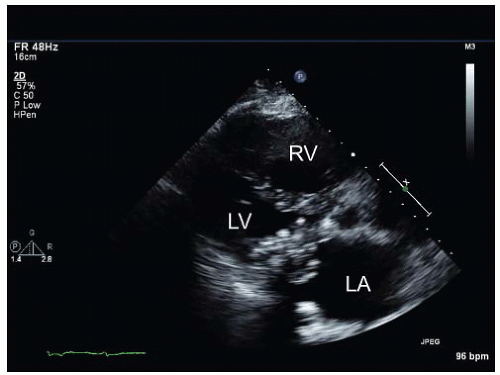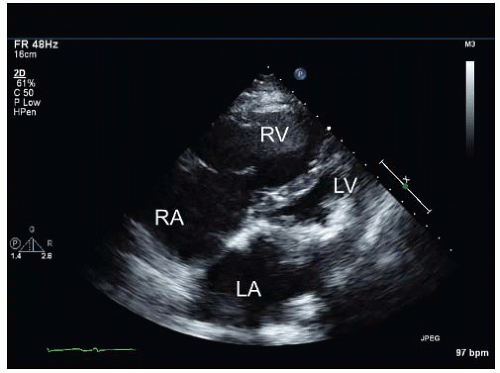Profound Hypertension after Hemodialysis
A 71-year-old woman with diabetes mellitus, hypertension, end-stage renal disease, status post mitral valve replacement, and history of bacteriemia presents with profound hypotension after hemodialysis.
A. A degenerated mechanical mitral valve prosthesis
B. A dilated right ventricle, along with a mass on the mitral valve
C. A dilated right ventricle, along with a tumor in the left atrium
D. A degenerated mechanical mitral valve prosthesis and a dilated right ventricle, along with a tumor in the left atrium
View Answer
ANSWER 1: B. The images are obtained from the parasternal long-axis and subcostal views and demonstrate a markedly dilated right ventricle, a small left ventricle, and a large mass on the mitral valve. The mass partially obscures the valve structure, but there is no evidence of a mechanical mitral valve.
A. A mitral valve vegetation
B. Severe mitral regurgitation
C. Severe mitral stenosis
D. A mitral valve vegetation and severe mitral stenosis
E. A mitral valve vegetation and severe mitral regurgitation
View Answer




ANSWER 2: C. Figure 61-3 (Video 61-3) shows a large vegetation on a bioprosthetic mitral valve. Although the valve leaflets are not visible, the struts can be seen. Figure 61-4 (Video 61-4) shows a turbulent diastolic mitral inflow with large proximal isovelocity surface area in the left atrium, consistent with significant mitral stenosis. The continuous wave Doppler (Fig. 61-5) confirms critical mitral stenosis with a mean diastolic gradient of 34 mm Hg and a peak gradient of 48 mm Hg. There is no evidence of significant mitral regurgitation.
Stay updated, free articles. Join our Telegram channel

Full access? Get Clinical Tree




